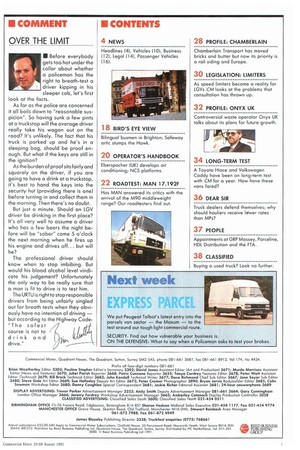• COMMENT OVER THE LIMIT
Page 3

If you've noticed an error in this article please click here to report it so we can fix it.
• Before everybody gets too hot under the collar about whether a policeman has the right to breath-test a driver kipping in his sleeper cab, let's first look at the facts.
As far as the police are concerned it all boils down to "reasonable suspicion". So having sunk a few pints at a truckstop will the average driver really take his wagon out on the road? It's unlikely. The fact that his truck is parked up and he's in a sleeping bag, should be proof enough. But what if the keys are still in the ignition?
As the burden of proof sits fairly and squarely on the driver, if you are going to have a drink at a truckstop, it's best to hand the keys into the security hut (providing there is one) before turning in and collect them in the morning. Then there's no doubt.
But just a minute. Should an LGV driver be drinking in the first place? It's all very well to assume a driver who has a few beers the night before will be "sober" come 5 o'clock the next morning when he fires up his engine and drives off... but will he?
The professional driver should know when to stop imbibing. But would his blood alcohol level vindicate his judgement? Unfortunately the only way to be really sure that a man is fit to drive is to test him.
The URTU is rightto stop responsible drivers from being unfairly singled Out for breath tests when they obviously have no intention of driving — but according to the Highway Code: "The safest course is not to drink and drive."












































































